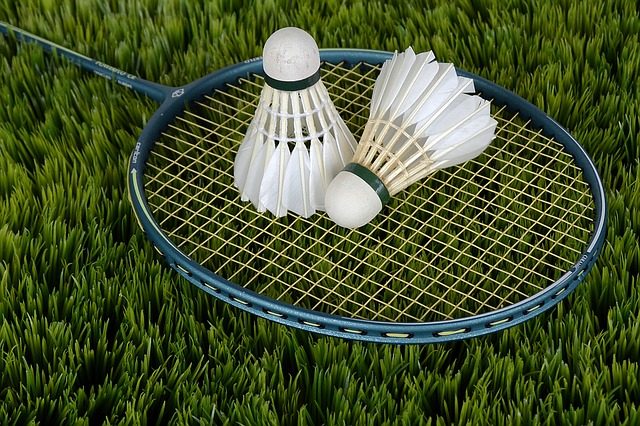Shuttle and badminton are two entirely distinct racket sport though they appear to be alike and similar in some techniques, style and even, court of play. Respectively, one still need to use a shuttlecock attached with a plastic skirt that takes the shape of a feather and the other a yellow ball specially covered with wool synthesis. Taking an intensive and much closer look at both parties, the difference between shuttle and badminton will be vividly revealed.
Badminton is a native sport originated from India. It is a racket game usually played with using a yellow ball made out of wool. The badminton court has a fixed dimension of about 12 by 24 meters separated by a net. The game has been in existence since 1856 by the royal family who existed in Tanjore, which is the capital of Thanjavur territory in India, Tamil Nadu to be precise.
The territory has the largest population in India during that time. Ball badminton is a quick-paced game; it requires skills, snappy reflexes, good decision-making ability, agility, and capacity to control the ball effectively with one’s wrist.

Shuttle, on the other hand, is regarded as a racquet sport played by making use of racquets to hit the shuttlecock over a net. In spite of the fact that it might be played by larger teams, the most widely recognized category of the game are “singles” (with a player for each side) and then, “doubles” (with two players for each side).
The game of badminton is usually played as an outdoor game in a beach or yard; formal games are played across a rectangular indoor court. By hitting the shuttlecock using the racquet and landing it on the opponent side of the court, points are gained.
Differences Based on Equipment
Discussed below are major differences between shuttle and badminton based on the equipment being used for the sport.
Badminton
The ball
This is a yellow wool, having a weight of 22 to 23 grams and a diameter of 5 to 5.5 cm.
Rackets
A standard racket for ball-badminton. It has a weight ranging from 200 to 250 grams and a length ranging from 63 to 70 cm. The badminton racket has a strung oval area of around 20 to 22 crosswise over and a length of around 24 to 27 cm.
The Net
This is made of fine string to form a 2 cm square mesh across its length and is being edged at the top using a red tape. The whole net is, blue, white and red, 13.5 meters long and 100 cm wide. It is being tied to a middle pole of 183 cm long and two poles of 185cm long at the two sides of the court in order to make the net to have a height of 183 cm in the middle.

Two Posts
Every 2 meters high poles are each fixed at the finish of the line and separated by one meter tight enough for the net to stretch well. A hook is hanged at a height of 1.5 meters to each pole in order to effectively have a tight when required.
Shuttle
Rackets
These are lightweight, weighing between the range of 70 to 95 grams excluding strings or grip. They are made out of a wide range of materials such as carbon fiber composite (also known as graphite reinforced plastic), solid steel, which might be augmented by other kinds of materials. Carbon fiber has a fantastic quality to weight ratio, is solid, and gives magnificent transfer of kinetic energy
Strings
These are thin cords that have around 0.62 to 0.73 mm thickness. Thicker strings have proven to be tougher, yet numerous players love to get the thinner strings.
Grip
This kind of grip enables a player to adjust the handle thickness of their racquet and a have a convenient surface to hold. A player may construct the handle with either just one or a few grasps previously applying the last layer.
Shuttlecock
(Usually shortened to shuttle; otherwise called a birdie) is regarded as a high-drag projectile, having an open tapered shape: the cone is framed from sixteen covering feathers inserted into a curvy cork base. The cork is surrounded with a synthetic material or thin leather. Recreational players usually make use of these synthetic shuttles to decrease their expenses as feathered shuttlecock tends to easily break. These nylon shuttles are built with either synthetic foam base or natural cork and a plastic skirt.
Shuttle shoes: are lightweight built with soles of rubber
Other Differences Between Shuttle and Badminton
Shuttle is usually compared, most of the time with Badminton. Listed below are some manifest comparisons:
- Scoring: In the game of shuttle, a match is played well in 2 out of 3 games. Each game should have 21 points. In tennis, a match is played well in 3 out of 5 sets, each set comprising of 6 games and the games are concluded when a player wins up to 4 points or at deuce points, gains 2 consecutive points. But in case both teams are held up at game-point, then they will need to play until one accomplishes a 2-point advantage. So, at 29–all, anyone who scores the brilliant point will win the game. In badminton game, if the score is held up 6–6 of every set, a tiebreaker round will be played, and this comes to a conclusion once a player wins 7 points or when a player has a 2-point advantage.
- In badminton game, the ball may bounce back once before an end in the points occur; but in the game of shuttle, there is an end in the rally once the shuttlecock reaches the ground
- In badminton, the serve is highly dominant to the degree that the server is relied upon to win majority of his service attempt (at expert level and onwards); a service break, where the server loses, is highly significant in a match. With regards to shuttle, a server has a less favorable position and is probably not going to win an ace i.e. unreturnable serve.
- In the game of badminton, the server is given two attempts to hit a serve directly into the box; while in the game of shuttle, the server is given just a single attempt.
- A court for badminton is almost double the width and length of the court for shuttle.
- Badminton rackets are almost four times as weighty as rackets for shuttle, 10-12 ounces Vs 2-3 ounces. Balls for badminton are more than eleven times weighty compared to shuttlecocks, 2.0 ounces Vs 0.18 ounces.

Conclusion
We hope this article has been able to do justice to the differences between shuttle and badminton. The fans of badminton and shuttle usually believe that their game Is more physically demanding, but such comparisons are hard to make objectively as a result of the varying demands of the sports.
No formal investigation currently exists assessing the player’s physical state or demands when playing the games. So with the above information, you should be able to differentiate, compare and contrast between shuttle and badminton.





